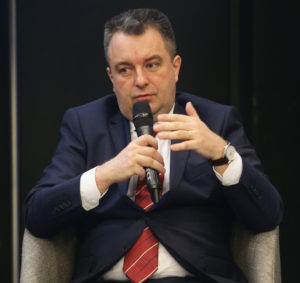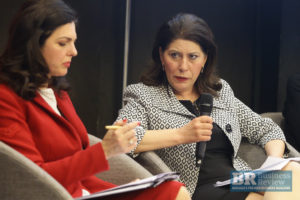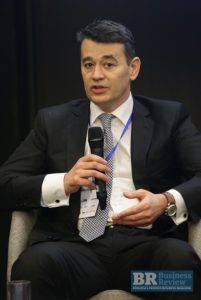:quality(80)/business-review.eu/wp-content/uploads/2018/03/Smalllogo_NEAN9314.jpg)
Here are the main statements from the 16th edition of the Tax&Law Conference organized by Business Review on Tuesday.
Oana Iacob, state secretary, Ministry of Finance:
The plans for the next period focus on simplification and reduction of red tape. A draft bill for the simplification of reporting and payment of taxes paid individuals reporting income from independent sources.
We will continue on the same line of simplification and reduction of red tape (…) there are plans to simply reporting for activities carried out by companies. She said that the government expects the feedback from companies.
Romania has an attractive fiscal framework from the perspective of investments.
The consolidation of some statements (single statement for income tax and social contributions) – 7 in 1 for individuals.
From next year, the statement will be made in an electronic system, this year the reporting will also be done in paper format.
The reporting can be done through the fiscal private space or through the e-guvernare platform where the digital signature is required once the draft bill is published in the Official Gazette.
“There will be a single deadline for submitting the single tax statement. For 2018, the deadline will be July 15 2018 for completing the fiscal year 2017 and for the estimate of income for 2018. Starting 2019, the deadline will be March 15,” said Iacob.
The fiscal statement can be corrected (updated) depending on the income realized by individuals.
There will be a bonus system in 2018 for stimulating the submission of the statement online. There will be a 5 percent bonus out of the taxes paid by March 15 2019. There will be another 5 percent bonus if the annual estimated taxes will be paid by December 15.
On income tax, we are talking about taxpayers that have to submit Form 200. On the mandatory social contributions, on CAS (healthcare contribution) as area of activity it refers to is independent activity.
“On the income from investments, the tax obligations are included on CASS (social security insurance contributions) not CAS. From this perspective, if the income from investments exceed the annual threshold of RON 22,500, there will be the obligation of payment at the level of the minimum wage no matter the reported income,” said Iacob.
Marius Ionescu, Tax Partner and Co-Head of NNDKP Tax Advisory Services:
The prevention law refers to contraventions, it encompasses hundreds of contraventions from all fields. The first time, authorities issue a warning and make a support program, 10 days later they return to see if the issues were

solved.
In the fiscal area, the contraventions include the delay in the submission of tax forms or the transfer prices files.
The draft bill is welcomed. All the entities with control attributions need to make their control and support procedures public.
I’m waiting to see the control procedures of ANAF made public.
For smaller tax payers this is important (…) but a large taxpayer has departments that track all these things.
“The idea behind is more generous and refers to prevention, support for companies and transparency in the control field. (…) The ANAF should treat the taxpayer as its client,” said Ionescu.
Mirela Calugareanu, president of ANAF:
The National Agency of Fiscal Administration (ANAF) head spoke about the need to remedy the lack of a definition of tax evasion in current legislation and announced the creation of a Mediation Council aimed at reconciling tax payers and the tax body and limit the number of challenges and litigations.
“Raising the level of expertise of ANAF employees will bring benefits. By the end of March the Ministry of Finance told its experts to create a working group to tackle the streamlining of the procedure of fiscal administration for companies. In this context, the approach must have two components: first, preventive measures and second, very firm and strict measures for those who try to elude the system,” Calugareanu said.
 “You already know that ANAF has started a type of preventive activities where we are based less on inspections. Instead, we perform partial inspections based on risk analyses. We look at the amounts declared and give a deadline for compliance instead of starting a general inspection. This allows us to cut our costs.
“You already know that ANAF has started a type of preventive activities where we are based less on inspections. Instead, we perform partial inspections based on risk analyses. We look at the amounts declared and give a deadline for compliance instead of starting a general inspection. This allows us to cut our costs.
Both us and the business environment feel the need for a dialogue in what regards the need to bring together all institutions involved in managing these realities. Because if we study the legal framework – the law does not provide a definition of tax evasion,” the ANAF head stressed.
Soon electronic levy will be lifted electronically
“There is a good news. The electronic levy on someone’s account is now possible and we made half a step ahead. We also had a deadline for the other half – lifting the electronic levy – and that stretched until July. But we have the presidential order now. That is why, we hope that within a month’s time to be able to perform the lifting of the electronic levy also electronically,” the ANAF head announced. “When more accounts are available, the ANAF will only put a levy on the amount required using one account only, if the amount is available there.”
“Those who know they must pay contributions know it is a challenge to obtain a rescheduling. The file one needs to submit in order to obtain a rescheduling of payments is very thick. It is necessary to identify guarantees from the company’s assets, third parties or other. In the future, a tax payer with financial obligations who does not have the possibility to pay them will be able to notify and make a payment schedule for a period of 6 months. They will not need to wait for approval from the tax body,” she said.
“Our goal is to allow our staff to relocate to other activities. We want to free increasingly more our staff, which was up until now involved in carrying out repetitive activities as well as the staff involved in finding solutions for litigations, provided that these activities are regulated in a different way. We want their number to drop and the reaction time to also decrease considerably,” Calugareanu added.
We want to create a Mediation Council
“We will have to collect all opinions of the business environment to see whether it is possible to implement a Mediation Council that will intervene in fiscal inspections and administration. During the fiscal inspection we have the stage of hearings. The purpose of this council would be to reconcile the tax payer and the tax body so that the first can’t challenge the latter in court. We are looking around to other countries for best practices and we have seen that other countries have such a thing – the UK, Poland. It will gather ANAF experts as well as representatives of the professional and the business environment. We are expecting a drop in the number of challenges and litigations,” she said.
The council will act after the final discussion. The reason for this is that we know, from experience, that in few cases the parties reconcile at this stage, Calugareanu explained.
There will be transparency regarding risk criteria
“What does the ANAF do to support the collection of taxes? I already spoke about preventive measures and I can tell that they had a positive impact. The economic growth reflected in a 1.5 percent increase of payments towards the consolidated budget. The collection level in the first two months of 2018 is also looking good. But as a parallel measure, encouraging the voluntary conformation is important. We created within the ANAF the General Directorate for Risk Assessment – out of the need to create a risk profile of the contributor. And the risk profile will represent the element via which we will conduct the future interaction with the tax payer,” Calugareanu explained.
“This week we have a meeting with representatives of the business environment to discuss the topic of the VAT. We are open to discuss the parameters that we take into account when making a risk assessment.
We will continue to be transparent regarding the procedures and the risk criteria. We are in an advanced stage with the creation of the procedure for the prevention law. And we are taking a look at the good practice of other European countries. We want to assist, to prevent, because this is the way to increase voluntary compliance. For more tax payers to want to comply. All of our measure, those you can and those you cannot see are targeted at improving this. What we want is to free our staff from routine work and to re-channel their efforts to assist the tax payer,” she said.
“In the upcoming two weeks, all of our employes will participate in a general training because they need to be able to explain to tax payers around the country – and also in the countryside and there we expect to encounter difficulties – because we must change the way in which taxes are perceived and paid,” Calugareanu added.
Tax payers will receive a name and password to pay taxes online
So far the development of the online space for individuals was not one of ANAF’s priorities, Calugareanu said. “That is because of the share this had in terms of tax collection. But we are planning to develop and adjust the way in which the private virtual space of private individuals is working. The same is still needed for companies. Just imagine that before all this data had to be put into the system by our employees and that involved a large volume of work and a possibility to make errors,” the ANAF head said.
“For this purpose, they will receive credentials – such as name and password. Every tax payer in the country will receive that in order to encourage and boost online tax payment. In the countryside as well we will promote that with the help of city halls. We will not make it compulsory starting this year but we will encourage that,” she announced.
ANAF will not give bonuses from fines
“We will not give stimulants/bonuses from fines. This would contradict prevention law. The purpose is to facilitate voluntary compliance and to develop an approach that is consistent with the realities of 2018. A project scheduled for the first quarter of this year is to develop a ‘school of taxes’ where our colleagues can train. We are working on a system to stimulate performance and you are welcome to become our partners and make suggestions,” the ANAF head said.
Madalina Nicola, head of accounting & payroll, Noerr Finance & Tax:
“Entrepreneurs have to be a little bit accountant, tax specialist and even an HR professional.”
The wage tax system was changed and the contributions of employers was cut. There are few companies that actually did not cover the cost of the fiscal changes.

Companies are impacted the same as they were in December, except the IT sector that took a hit, and the burden of the contributions moved to the employees.
In the IT, on fiscal facilities we have IT and R&D – less developed. Any company that wants to apply tax facilities for IT, it needs to have a CAEN for the creation of computer programming. This doesn’t apply for shared service centers.
The tax facilities for IT have been successfully implemented.
Students enrolled in a faculty with accreditation can benefit from fiscal facilities in the IT sector. New companies are exempted from the threshold of EUR 10,000 in income per employees in the first two years. This is a helping hand for companies that are just starting.
For IT and R&D, the tax facilities have to be very well documented.
Adina Vizoli Alexandru, tax partner, NNDKP Tax Advisory Services, on the shift in the payment of social contributions from employers to employees:
The overall costs of companies don’t change, except those active in IT, R&D.
 The ordinance 23 of split VAT aimed to secure the VAT to the state budget. Romania has the lowest VAT collection rate – 38 percent gap.
The ordinance 23 of split VAT aimed to secure the VAT to the state budget. Romania has the lowest VAT collection rate – 38 percent gap.
From August to December 2017 there were a series of amendments, said Alexandru, referring to the regulation of VAT split system. “This generated uncertainty that didn’t have any good contribution to the business environment,” she said.
At present, there aren’t those regulations that forced the VAT to remain in the VAT account. (…) At present, there is a category of taxpayers that have to apply the VAT split system – it is mandatory for those with certain debts to the state. Companies in insolvency are also forced to apply it. The system remains optional for the rest and there is a 5 percent break from the microenterprise tax.
Mihaela Pohaci, partner at PNSA Tax, spoke about the implementation of the Anti-Tax Avoidance Directive
The new measure includes the limitation of the deductibility of the excess indebtedness cost. In order to compute the deductible amount, this cost has to remain below the EUR 3 million threshold, according to the amendments approved by the Senate. Additional changes approved by the senators state that the deductibility costs of indebtedness that exceed this threshold will be limited at 30 percent of the computation basis. Initially, this figure stood at 10 percent.
indebtedness that exceed this threshold will be limited at 30 percent of the computation basis. Initially, this figure stood at 10 percent.
The financial institutions are excluded from the application of these rules, according to Pohaci.
Viorel Sbora, manager, Atipic Solutions:
“Any taxpayer doing transactions with affiliated entities needs to have a transfer pricing file. (…) It protects companies from a lot of headaches,” said Sbora.
The first change approved last year includes a dashboard for all multinational groups with a consolidated turnover above EUR 750 million. In includes a comparing fiscal position for each entity. It aims to show groups that have fiscal optimization scheme.
Starting the second part of 2013, we have seen a significant increase in the number of controls on transfer prices. One of the trends we have seen is the smaller duration for the preparation of transfer pricing files.
“The increase of controls for those with 2-3 years of consecutive fiscal losses,” commented Sbora, presenting one of the trends in the area of transfer prices.
“At present, all the compatibility reports should be done at the level of EU,” said the manager of Atipic Solutions.
We expect the increase of the affiliation threshold from 25 percent to 50 percent. At present, we do reports only at EU level due to the current aggressive approach of the authorities.
We recommend caution and to go and talk at group level. To attempt to re-position the transfer prices to have a fair allocation.
Raluca Buciuc, director | Romania, Valuation Services and Hospitality Advisory Services, Colliers International:
 In the last 2 years, we have seen a change in the taxable taxation from-40%,-50% to 40% to 50%, depending on the building replacement cost.
In the last 2 years, we have seen a change in the taxable taxation from-40%,-50% to 40% to 50%, depending on the building replacement cost.
Any building from the market should have the same value across the country.
The owner of an industrial building from a second or third-tier location has to pay a tax almost 50 percent than in the past because the reference replacement cost includes a building without a depreciation cost.
Mihaela Ionescu, CFO, Microsoft:
As a financial director nowadays, it’s a very challenging position becaus

e the position stays between the investor and the fiscal environment. The investments are becoming more limited. There is a competition inside companies for buckets of investments. We want a stable environment.
On the collection of VAT, I don’t see an increase in the collection rate from split VAT.
For IT companies, the shift of contributions for tax exempted employees meant an increase of costs with wages. I would advise for maximum prudence in the next few months.
Ciprian Ladunca, CFO, Metropolitan Life:
 The question is what’s happening across Romania, how prepared are the representatives of financial departments that have to submit the tax forms.
The question is what’s happening across Romania, how prepared are the representatives of financial departments that have to submit the tax forms.
There is an issue of consistency, of access to information, I think this is a big challenge.
The uncertainty impacts certain behaviors such as signing an insurance policy, starting a family.
Mircea Varga, CFO, Tiriac Holdings:
The constant challenges create certain insomnia. Romania, at taxation level is not that bad compared to the rest of the EU. The issue is that you can’t make predictions, certain fiscal changes make me wonder what was the purpose, I want to find out if it has an economic logic, but it raises questions from the perspective of sustainability.
We moved contributions of social security but I question if they will remain in place on the medium and long term.
We thought of a merger between companies to exceed a threshold of EUR 1 million for the taxation of micro-enterprises. It becomes a lower cost from a taxation perspective from companies that have a pre-tax profit margin of more than 6.25 percent.
The local economy is fractioned; it has a lot of companies with limited economic power. These changes hit mainly small companies that are in the development phase.
I would like to see efficiency, professionalism and trust from the perspective of tax authority representatives.
Sometimes I have the feeling that the changes are made only for an exception, for some that don’t pay taxes.
Dan Berciu, CFO, Eurolines Group
Middle East countries apply starting this year the VAT – discussions about this move appeared five years ago. Such changes including split VAT and on payroll, there are a lot of smaller companies grappling with this.
 The increase of the gross minimum wage to RON 1,900 coupled with the shift of contributions led to a reduction of the wage taxation.
The increase of the gross minimum wage to RON 1,900 coupled with the shift of contributions led to a reduction of the wage taxation.



:quality(80)/business-review.eu/wp-content/uploads/2024/07/Artenie_Theodor_mK_web_Noerr_20220525_2955.jpg)



:quality(80)/business-review.eu/wp-content/uploads/2024/06/22C0420_006.jpg)

:quality(80)/business-review.eu/wp-content/uploads/2024/06/COVER-1-4.jpg)



:quality(50)/business-review.eu/wp-content/uploads/2024/06/br-june-2.jpg)
:quality(50)/business-review.eu/wp-content/uploads/2024/06/br-cover-vtex.jpg)
:quality(50)/business-review.eu/wp-content/uploads/2024/05/returo-cover.jpg)
:quality(80)/business-review.eu/wp-content/uploads/2024/06/br-june-2.jpg)
:quality(50)/business-review.eu/wp-content/uploads/2024/07/Ilustratie-2.jpg)
:quality(50)/business-review.eu/wp-content/uploads/2024/07/VGP-Park-Timisoara_-8thbuilding_iulie-24.jpg)
:quality(50)/business-review.eu/wp-content/uploads/2024/07/America-House-Offices-Bucharest-Fortim-Trusted-Advisors.jpg)